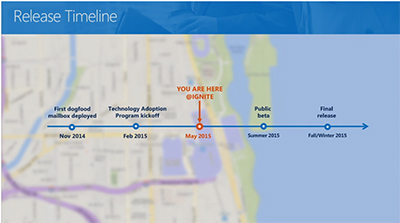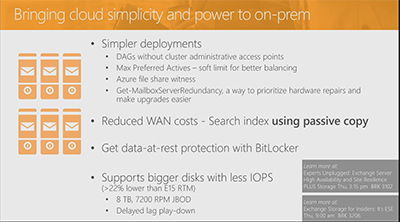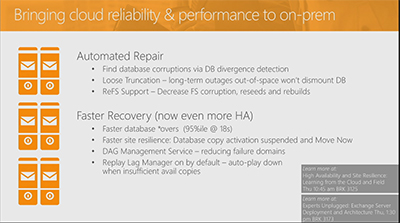News
Exchange Server 2016 Getting Deployment and Reliability Improvements
Microsoft offered a glimpse of Exchange Server 2016 at its Ignite event for IT pros this week.
The new mail server's bits have been undergoing testing by Technology Adoption Program participants since February. However, there's no public beta available yet. Microsoft is planning to release a public beta sometime this summer, with final product release expected by year's end (see chart), according to an Ignite "Meet Exchange Server 2016" session, available on demand here.
 [Click on image for larger view.]
Figure 1. Exchange Server 2016 release timeline. Source: Ignite 2015 session.
[Click on image for larger view.]
Figure 1. Exchange Server 2016 release timeline. Source: Ignite 2015 session.
With this release, Microsoft is focusing on improving the server's performance, reliance, fault tolerance and simplicity, according to Jon Orton, a director at Microsoft. The new server will be designed so that organizations can keep their mailboxes on premises while also tapping cloud services.
Architecture Changes
Microsoft explained in a blog post that it has removed the Client Access server role from Exchange Server 2016. The Mailbox role instead will be getting a client access services component. These changes were made to reduce the number of physical servers needed to run Exchange, thereby potentially reducing hardware costs, as well as licensing and maintenance costs, that might be associated with running separate servers to house Client Access server roles.
Mailbox servers can be added to a Database Availability Group to add high-availability protection to Exchange Server 2016 deployments. In such cases, Microsoft claims that "database failovers times are reduced 33% when compared to Exchange Server 2013," according to the blog post.
Microsoft is also promising coexistence between Exchange Server 2016 and Exchange Server 2013. The Client Access server role in Exchange Server 2013 is described as an "intelligent proxy" that doesn't process content, so there's no need to "move the namespace" between the two server installations. Additionally, the load balancers "contain a mix of Exchange Server 2013 and Exchange Server 2016." That circumstance gives IT pros the ability to swap out Exchange 2013 servers for Exchange 2016 servers, the blog explained.
The preferred architecture for Exchange Server 2016 will be "very similar to the Exchange 2013" preferred architecture, according to Microsoft's blog post. Karim Batthish, a group program manager at Microsoft, explained during the Ignite talk that the architecture of Exchange Server 2016 is "an evolution and refinement of Exchange Server 2013."
The upgrade path to Exchange Server 2016 wasn't discussed during this Ignite session, but there will be no direct migration route from Exchange Server 2007. Here is how Brian Day, a senior program manager of the Exchange customer advocacy team at Microsoft, explained it in Microsoft's blog post:
You can coexist/upgrade from 2010 SP3 to 2016 in the same AD forest, but not from 2007. Setup will not allow you to install 2016 if 2007 exists in the Exchange org. We will announce the required 2010 SP3 update rollup and 2013 CU for coexistence/migration closer to 2016's release.
Server Improvements
The Ignite talk suggested that Microsoft was bringing some of its Exchange Online cloud service learnings to the new premises-based server product. Microsoft is promising simpler deployments, reduced wide area network (WAN) costs, BitLocker protection of data at rest and support for larger disks in Exchange Server 2016 (see chart).
 [Click on image for larger view.]
Figure 2. Exchange Server 2016 deployment improvements. Source: Ignite 2015 session.
[Click on image for larger view.]
Figure 2. Exchange Server 2016 deployment improvements. Source: Ignite 2015 session.
Microsoft is also promising a few reliability improvements in the new server. Exchange Server 2016 will have some automated repair features, as well as faster recovery from failures (see chart).
 [Click on image for larger view.] Figure 3. Exchange Server 2016 reliability improvements. Source: Ignite 2015 session.
[Click on image for larger view.] Figure 3. Exchange Server 2016 reliability improvements. Source: Ignite 2015 session.
Batthish explained in the Ignite talk that Exchange Server 2016 has a "database divergence detection" feature. It's designed to look for corruptions and failures.
Other improvements coming to Exchange Server 2016 include a "data loss prevention" scheme for warding off information disclosure issues by end users. Microsoft is also bringing e-discovery tools for searching e-mail archives across an organization using analytics based on its Equivio acquisition. Exchange Server 2016 also will get an audit log structure that's similar to the one used for Office 365 services. The new audit capabilities will integrate with third-party software products.
Client Improvements
About half of this Ignite talk described improvements to the Outlook desktop client and the Outlook Web App client. Microsoft has been improving them in terms of document collaboration and mobile productivity.
Kip Fern, a senior program manager lead at Microsoft, described infrastructure options to enable document collaborations. His live demo in the Ignite session involved a fully on-premises environment consisting of Exchange Server 2016, SharePoint Server 2016 and Office Web Apps Server 2016, hosted from Redmond, Wash. He noted it's also possible to have a hybrid setup where SharePoint documents are stored in the cloud instead of on premises.
Fern said that Microsoft had solved some document collaboration issues with the new technology. Permissions to edit or view a document are set up automatically when e-mails are sent. Versioning issues associated with multiple people working on different document versions are addressed.
He also explained how this new technology gets around a file-size sharing limit associated with Outlook Web App attachments. If a file over 5MB is attached, Outlook Web App will recommend using SharePoint instead to send it. "No longer will you have any issues with large files," Fern claimed.
The new Outlook client will have a "smart in-box" that will make it easier to find e-mails and attached documents. Microsoft speeded up getting results from search queries in Outlook. Search now delivers suggestions based on the data in the mailbox, as well as key words that come from e-mail content. It's also possible to search calendars using the new Outlook Web App.
About the Author
Kurt Mackie is senior news producer for 1105 Media's Converge360 group.